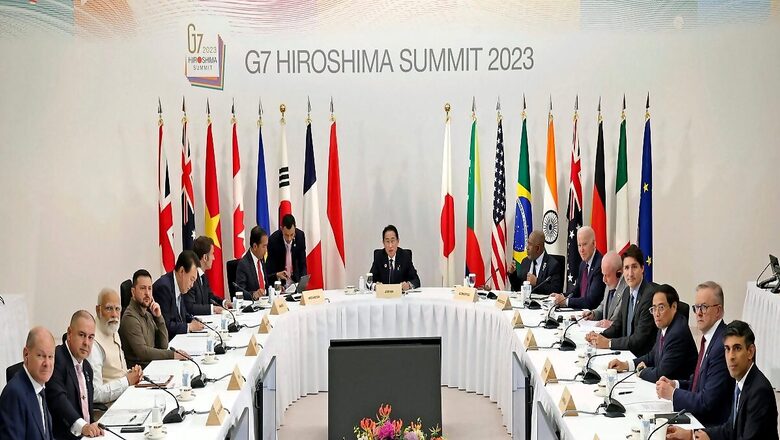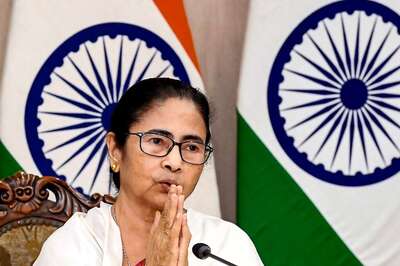
views
The Hiroshima G7 summit communiqué exposes the gap between principle and practice and between rhetoric and reality. Choosing Hiroshima as the venue of the summit sent a confusing message. Hiroshima was the victim (along with Nagasaki) of the only time a nuclear weapon was used in war, and that too against a civilian population. Hiroshima should then have been the platform to explore peace everywhere and, in particular, prevent the escalation of any conflict with a nuclear dimension.
If holding the summit at Hiroshima was to send a message of peace, that goal was not served by inviting President Volodymyr Zelenskyy to the summit to demonstrate G7 support for him by way of supply of arms and finance to continue boosting his capacity to fight militarily with the ambition to wrest back the regions annexed by Russia. No peace initiative surfaced from the summit.
On the contrary, the G7 communiqué offers support to Ukraine “for as long as it takes”. This open-ended support is intended to achieve what? A partial or total military defeat of Russia? Is that realistic? Will that come without terrible cost for the Ukrainian people (and loss of lives in Russia), however determined they are to defend their country and however righteous they may feel about their cause?
Ukraine rejects any negotiation with Russia, except on its own seemingly unrealistic terms, but which have the West’s support for the time being. Ukraine’s peace formula envisages Russia’s military defeat, reparations by Russia for war damage and war crimes trials of Russians. Even so, negotiation with President Vladimir Putin’s Russia does not seem permissible any more under a decree passed by President Zelenskyy. Yet, the Ukrainian president is seeking support for his peace formula internationally. At the end of the summit, instead of any move towards dialogue and diplomacy, unwavering G7 support and an additional $375 package of arms aid was announced by the US.
There are other ironies associated with Hiroshima as the summit venue. Hiroshima represents the only time that nuclear weapons were used in history. The leader of the country that used those weapons was the honoured guest at Hiroshima. President Barack Obama no doubt had visited Hiroshima in 2016 when Japan hosted the G7 meeting at a very different venue, in Ise-Shima. His guest book entry at Hiroshima said: “We have known the agony of war. Let us now find the courage, together, to spread peace and pursue a world without nuclear weapons.”. Cryptic words that admit no guilt, suggest that the US too was a victim of war equally with Japan, and end with a meaningless homily on a nuclear-weapon-free world. In 2016 President Obama actually authorised a nuclear modernisation programme costing $1 trillion over 30 years. President Joe Biden laid a wreath at the bombing site but did not apologise for the use of nuclear weapons.
Ironically again, Japan wholeheartedly accepts nuclear protection from the same country that used nuclear weapons against it. Normally, this should have put Japan in a moral quandary, but Japan evidently prioritises security over moral sensitivities. This may be understandable at one level in view of Japan’s decision to forego the nuclear option and the nuclear threat it faces, especially from North Korea, but Japan’s activism on the nuclear issue has a moralistic dimension that strikes a discordant note with its own reality.
Sections of our press thought that India’s presence at Hiroshima as a country that had not signed the NPT had an element of awkwardness. This was raising a non-issue as in July 2017 India and Japan signed an “Agreement for Cooperation in the Peaceful Uses of Nuclear Energy”. Japan, of course, continues to ritualistically call for early entry into force of the CTBT and early conclusion of negotiations on a non-discriminatory and verifiable FMCT, even as the US, the prime mover of these treaties, has lost interest in them some years ago. These calls have figured in the joint statement issued during the India-Japan summit in March 2023, not as a joint view, but as Japan’s view. The “G7 Leaders’ Hiroshima Vision on Nuclear Disarmament” contains a lot of posturing on the nuclear issue, with lip service to the “ultimate goal of a world without nuclear weapons” with such caveats as to make this goal indeterminate as the approach will be “realistic, pragmatic and responsible”.
Many aspects of the G7 statement do not bear scrutiny. It says that its work is rooted in international partnership, whereas in key areas it does not appear to be so. The G7 intends to continue supporting Ukraine without let irrespective of the consequences of this European conflict for the interests of developing countries. Does the decision to “intensify military support to Ukraine to increase costs for Russia” promote either the claimed wider partnership objectives or multilateralism, when most countries are opposed to sanctions on Russia because of serious secondary consequences for them? If “Russia’s brutal war represents a threat to the whole world”, the answer should be to search for a global consensus on finding a route to dialogue and peace rather than put all the emphasis on condemnation of Russia and a military solution.
The stated G7 disarmament goals are not being strengthened with the US decision to withdraw from the INF Treaty and uncertainty around the Start II Treaty stemming from the Ukraine conflict. Working for the “ultimate goal of a world without nuclear weapons with undiminished security for all” can hardly be achieved if it has not been possible to implement even the concept of “indivisibility of security in Europe” (included in the Helsinki Final Act of 1975 and reiterated in the CSCE Helsinki Document of 1992 and Lisbon Summit of 1996) where a dangerous nuclear fault line has been opened.
The G7 joint statement speaks of economic resilience and economic security, diversifying and de-risking of supply chains instead of decoupling, which is an acknowledgement of the impracticality of decoupling their economies from China. The drawing back from the decoupling rhetoric gives space not only to US interests but those of Europe and Japan to maintain their vital economic ties with China. The usual references to free and open Indo-Pacific and opposition to unilateral attempts to change the status quo by force or coercion is directed at China’s threats to Taiwan in particular. The G7 intends to strengthen coordination with regional partners such as the ASEAN, recognising ASEAN centrality and the ASEAN Outlook on the Indo-Pacific. The partnership with Pacific Island countries stems from China-related concerns. So is the reference to a rules-based multilateral trading system and trustworthy AI in line with democratic values.
There are references to the transition to clean energy, resilient global food security, allocating $60 billion for financing quality infrastructure through PGII [Partnership for Global Infrastructure Initiative (prodded by China’s BRI)], Sustainable Development Goals, strengthening partnerships with Africa and African representation in multilateral fora (spurred also by China’s penetration of Africa), de-carbonisation of the G7 energy sector, deepening cooperation on Just Energy Transition Partnerships. A Pandemic Fund for supporting vaccine manufacturing capacity worldwide figures in the joint statement even though the Indian and South African efforts at the WTO to obtain a TRIPS waiver for manufacturing anti-Covid vaccines and treatments in developing countries have not succeeded, with opposition, particularly from the EU.
The short point is that the G7, however powerful it still is in the global system, is no longer in the same dominant position as before, recognised years ago with the decision to form the G20 where other major world economies are also represented. The G20, which includes both China and Russia, is, unfortunately, not any longer in a position to develop the required consensus on vital global economic and financial matters. The agendas of the G7 and the G20 are no longer shared in vital respects, given the deep divide that has arisen between the US and Europe on one side and China and Russia on the other on political, economic, financial and security issues, with countries of the Global South, too, having their own priorities.
Some headline agenda items may be shared by the G7 and the G20 but cooperation to achieve the broad objectives is not feasible when the two sides treat each other as adversaries, the political atmosphere has become fraught, global supply chains have been disrupted, globalisation is being reversed, finance has been weaponised, diluting the hegemony of the US dollar has become an objective, the re-militarisation of key countries is afoot, alliances are being strengthened or formed, and all such negative developments.
Kanwal Sibal is a former Indian Foreign Secretary. He was India’s Ambassador to Turkey, Egypt, France and Russia. The views expressed in this article are those of the author and do not represent the stand of this publication.




















Comments
0 comment